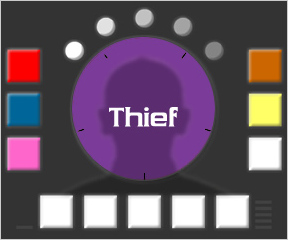![]()
 A Flash design project by Phillip Reagan of Texas, USA, Thief weaves a cryptic atmosphere with captivating puzzles to pull you into a story you didn't even realize you were participating in.
A Flash design project by Phillip Reagan of Texas, USA, Thief weaves a cryptic atmosphere with captivating puzzles to pull you into a story you didn't even realize you were participating in.
You begin staring at a table that holds a monitor and a strange box. You can click on either object, one leads to a puzzle with rotating triangles while the other has some unusual buttons and a beeping grid. No explanation is given, you just have to figure things out on your own. And I surely won't ruin the fine experience with spoilers in this review! It isn't until you solve a few of the puzzles that you realize the story behind the game and learn just why it's called Thief. The atmosphere is extremely mysterious and draws you in from the moment you begin. Warning: you will be hooked.
 Analysis: My first foray into Thief happened to be the radar-like puzzle on the right. It's entirely possible to complete the game starting here, but only if Lady Luck happens to be a close relative. Needless to say I didn't last very long and went to give the flashing grid a try. Coming up with the solution was fairly intuitive, but progressing through the series of puzzles proved a little more difficult. I quickly learned to pay attention to the small details that were repeated throughout the mini-puzzles. I snatched some paper and kept notes that turned out to be priceless. And the moment I learned the story behind the game, I was completely hooked.
Analysis: My first foray into Thief happened to be the radar-like puzzle on the right. It's entirely possible to complete the game starting here, but only if Lady Luck happens to be a close relative. Needless to say I didn't last very long and went to give the flashing grid a try. Coming up with the solution was fairly intuitive, but progressing through the series of puzzles proved a little more difficult. I quickly learned to pay attention to the small details that were repeated throughout the mini-puzzles. I snatched some paper and kept notes that turned out to be priceless. And the moment I learned the story behind the game, I was completely hooked.
The pacing and difficulty are perfect in Thief, keeping you on the verge of frustration so you keep plugging away for the solution. I like the open-ended feeling (though it's an illusion) and using clues from one puzzle to the next is a great way to create a fuller sense of satisfaction, especially in a smaller project of this nature.
Just like the other finalists in the competition, Thief drops you in the middle of a puzzle (or set of puzzles) and leaves you to your own wits to find a way out. It's captivating, creative, and enormously rewarding to play. Phillip has done a wonderful job and is deserving of one of the top prizes!
![]() dancemonkey: This was hands-down my favorite of all the entries. I loved the story, and loved that you didn't get to discover the story until you'd solved a fair amount of the puzzle itself. The puzzles were my favorite variety: they required experimentation and observation to figure out the mechanism, but once you'd deduced the solution none of them required a great deal of time to actually solve. I actually felt proud of myself when I finished the game!
dancemonkey: This was hands-down my favorite of all the entries. I loved the story, and loved that you didn't get to discover the story until you'd solved a fair amount of the puzzle itself. The puzzles were my favorite variety: they required experimentation and observation to figure out the mechanism, but once you'd deduced the solution none of them required a great deal of time to actually solve. I actually felt proud of myself when I finished the game!
![]() Jay: Although Thief strays a bit from the theme of the competition by including several puzzles to solve, most of the puzzles are, in fact, exactly what I was hoping to see. Not only are they great puzzles, they are also brilliantly woven together into a seamless game play experience that is engaging and enjoyable from beginning to end. Creative and original, with an overarching narrative that steals away your innocence as third person observer, Thief belongs among the best of this Casual Gameplay competition.
Jay: Although Thief strays a bit from the theme of the competition by including several puzzles to solve, most of the puzzles are, in fact, exactly what I was hoping to see. Not only are they great puzzles, they are also brilliantly woven together into a seamless game play experience that is engaging and enjoyable from beginning to end. Creative and original, with an overarching narrative that steals away your innocence as third person observer, Thief belongs among the best of this Casual Gameplay competition.
![]() Noah: Thief is a perfect example of what I was looking for in the contest entries: great puzzles—some very delicious—and a lot of personality. It even offers a creative back story to those willing to put forth a bit of effort. Though, if we could only take a peek inside that book...
Noah: Thief is a perfect example of what I was looking for in the contest entries: great puzzles—some very delicious—and a lot of personality. It even offers a creative back story to those willing to put forth a bit of effort. Though, if we could only take a peek inside that book...






Walkthrough Guide
(Please allow page to fully load for spoiler tags to be functional.)
Thief Walkthrough
The Monitor
Puzzle 1:
Click the PC monitor. The monitor consists of three cells on the left and right, and five at the bottom. The cells on the side are where you pick up colors. The cells on the bottom are where you arrange the colors. The five buttons at the top can be clicked in order to activate the clues to the puzzle.
Upon clicking a button, the center circle changes to a color and beeps are heard. Write down the color and the number of beeps heard. Repeat with each button until you have all five pairs (Color - Number).
Now, arrange the colors in the bottom cells from least number of beeps to most number of beeps, left to right. You need not click and drag, simply click the color you wish to use and click the cell you wish to transfer it to.
Puzzle 2:
For the moment, ignore flashing pie at the bottom left. Click any one of the dashed entries. These puzzles seem tricky but are relatively simple. The objective is to make it so the sum of all the cells' values add up to the number at the top. Clicking a cell increases it by 1. However, each time you click a cell, the two cells next to it increase by whatever value the cell you just clicked was.
For example: Click the top left cell, it becomes 1. Click it again, it becomes 2 and the middle top and middle left cells become 1. Click the top left again and it becomes 3, but the cells next to it have 2 added on, making each 3.
The simplest way to get the sum you need is to click one cell until you get the highest number before going over, then use the other cells to raise up the sum in small increments until you reach the goal. I specifically use the top left cell as my first one, then the bottom right, then the other two corners, so I could avoid adding more than 1 if necessary.
The Safe
Puzzle 3:
This puzzle can be solved using the pie image seen in puzzle 2. The trick to this puzzle is hovering the mouse over a colored triangle to freeze it. When the appropriate colored lines passes the triangle you've frozen, a triangle will be formed using the two lines of the two appropriately colored orbiting circles. Mess around until you understand how it works. The triangles will disappear if you position them incorrectly.
In order to position the triangles correctly, look at the pie image seen in puzzle 2. Try and line up a colored triangle so that it lines up with the side of the pie slice that has the same color. For example: The bottom right pie slice has a side that points straight down. Whatever color that slice is, freeze that same colored triangle when it points straight down, as that is one of the sides of that pie slice. It's easier to understand once you grasp that idea.
Puzzle 4:
The pie image from puzzle 2 is also used for the verification code. The pie slices flash in a clockwise fashion. Each entry on the monitor has a color that's paired with a pie slice. Type the numbers of the entries in order of the pie slice that flashes.
For example: If the brown pie slice is the first to flash, the brown entry's numbers are the first digits of the verification code.
Posted by: Sion Sheevok |
September 9, 2007 3:22 AM
|
September 9, 2007 3:22 AM